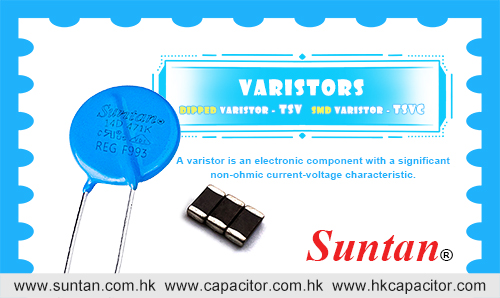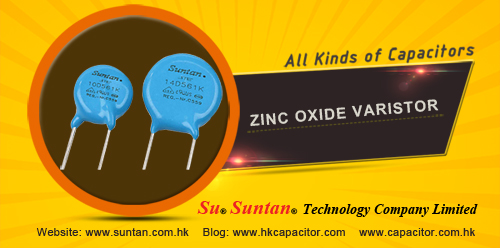Suntan Technology Company Limited
----All Kinds of Capacitors
Varistors are voltage-controlled resistors. They are common in outlet strips, Uninterruptible Power Supplies (UPS) and on electrical power lines.
Other names for varistors include current suppressors, lightning arrestors, surge arrestors and surge suppressors.
In the most common type of surge protector, a component called a metal oxide varistor, or MOV, diverts the extra voltage. an MOV forms a connection between the hot power line and the grounding line.
What is a metal oxide varistor?
A metal oxide varistor is a voltage-dependent, semiconductor-based, variable resistor. Electrically, it appears as an open circuit across a power line until its voltage threshold is reached. When this occurs, the varistor will instantaneously change from a high resistance mode (open circuit) to a low resistance mode (short circuit), thus conducting currents through it. Once the overvoltage event has passed and the voltage returns to below the threshold level of the varistor, it will return to an open circuit again until the next overvoltage event that exceeds its threshold occurs.
What is a surge protector?
A surge protector is an electronic device that limits transient overvoltages to a safe level, thus protecting equipment from damage or disruption. A surge protector may also be expressed using the following terms: SPD (Surge Protective Device), TVSS (Transient Voltage Surge Suppressor). An arrestor (used by utility companies and communication companies) is also a surge protector, but is typically employed in a different part of the electrical system than a surge protector.
Metal oxide varistors(MOVs) are among the most common devices used to provide surge protection for electrical and electronic circuits.
An MOV has three parts: a piece of metal oxide material in the middle, joined to the power and grounding line by two semiconductors.
These semiconductors have a variable resistance that is dependent on voltage. When voltage is below a certain level, the electrons in the semiconductors flow in such a way as to create a very high resistance. When the voltage exceeds that level, the electrons behave differently, creating a much lower resistance. When the voltage is correct, an MOV does nothing. When voltage is too high, an MOV can conduct a lot of current to eliminate the extra voltage.
As soon as the extra current is diverted into the MOV and to ground, the voltage in the hot line returns to a normal level, so the MOV's resistance shoots up again. In this way, the MOV only diverts the surge current, while allowing the standard current to continue powering whatever machines are connected to the surge protector. Metaphorically speaking, the MOV acts as a pressure-sensitive valve that only opens when there is too much pressure.
For more details please check : http://www.capacitors.hk/Varistor





